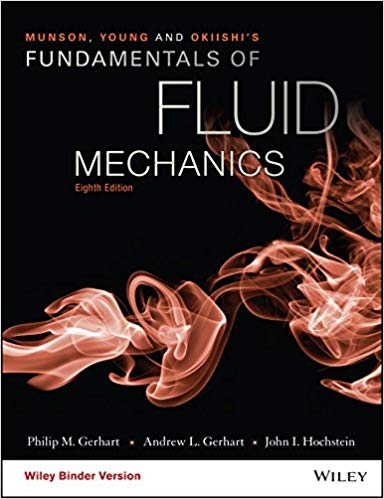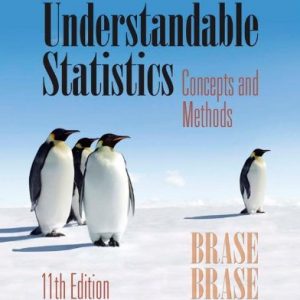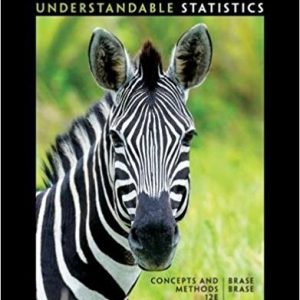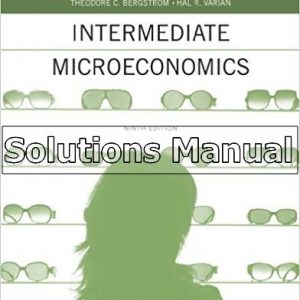Solution Manual for Munson, Young and Okiishi’s Fundamentals of Fluid Mechanics 8th by Gerhart

Product details:
- ISBN-10 : 1119080703
- ISBN-13 : 978-1119080701
- Author: Philip M. Gerhart
Fundamentals of Fluid Mechanic, 8th Edition offers comprehensive topical coverage, with varied examples and problems, application of visual component of fluid mechanics, and strong focus on effective learning. The text enables the gradual development of confidence in problem solving. The authors have designed their presentation to enable the gradual development of reader confidence in problem solving. Each important concept is introduced in easy-to-understand terms before more complicated examples are discussed. Continuing this book’s tradition of extensive real-world applications, the 8th edition includes more Fluid in the News case study boxes in each chapter, new problem types, an increased number of real-world photos, and additional videos to augment the text material and help generate student interest in the topic. Example problems have been updated and numerous new photographs, figures, and graphs have been included. In addition, there are more videos designed to aid and enhance comprehension, support visualization skill building and engage students more deeply with the material and concepts.
Table contents:
1 Introduction 1
Learning Objectives 1
1.1 Some Characteristics of Fluids 3
1.2 Dimensions, Dimensional Homogeneity, and Units 4
1.2.1 Systems of Units 6
1.3 Analysis of Fluid Behavior 11
1.4 Measures of Fluid Mass and Weight 11
1.4.1 Density 11
1.4.2 Specific Weight 12
1.4.3 Specific Gravity 12
1.5 Ideal Gas Law 12
1.6 Viscosity 14
1.7 Compressibility of Fluids 20
1.7.1 Bulk Modulus 20
1.7.2 Compression and Expansion of Gases 21
1.7.3 Speed of Sound 22
1.8 Vapor Pressure 23
1.9 Surface Tension 24
1.10 A Brief Look Back in History 27
1.11 Chapter Summary and Study Guide 29
References 30
2 Fluid Statics 31
Learning Objectives 31
2.1 Pressure at a Point 31
2.2 Basic Equation for Pressure Field 32
2.3 Pressure Variation in a Fluid at Rest 34
2.3.1 Incompressible Fluid 35
2.3.2 Compressible Fluid 37
2.4 Standard Atmosphere 39
2.5 Measurement of Pressure 41
2.6 Manometry 43
2.6.1 Piezometer Tube 43
2.6.2 U-Tube Manometer 44
2.6.3 Inclined-Tube Manometer 46
2.7 Mechanical and Electronic Pressure-Measuring Devices 47
2.8 Hydrostatic Force on a Plane Surface 50
2.9 Pressure Prism 56
2.10 Hydrostatic Force on a Curved Surface 59
2.11 Buoyancy, Flotation, and Stability 61
2.11.1 Archimedes’ Principle 61
2.11.2 Stability 64
2.12 Pressure Variation in a Fluid with Rigid-Body Motion 65
2.12.1 Linear Motion 66
2.12.2 Rigid-Body Rotation 68
2.13 Chapter Summary and Study Guide 70
References 71
3 Elementary Fluid Dynamics—The Bernoulli Equation 73
Learning Objectives 73
3.1 Newton’s Second Law 73
3.2 F = ma along a Streamline 76
3.3 F = ma Normal to a Streamline 80
3.4 Physical Interpretations and Alternate Forms of the Bernoulli Equation 82
3.5 Static, Stagnation, Dynamic, and Total Pressure 85
3.6 Examples of Use of the Bernoulli Equation 89
3.6.1 Free Jets 90
3.6.2 Confined Flows 92
3.6.3 Flowrate Measurement 98
3.7 The Energy Line and the Hydraulic Grade Line 103
3.8 Restrictions on Use of the Bernoulli Equation 106
3.8.1 Compressibility Effects 106
3.8.2 Unsteady Effects 107
3.8.3 Rotational Effects 109
3.8.4 Other Restrictions 110
3.9 Chapter Summary and Study Guide 110
References 111
4 Fluid Kinematics 112
Learning Objectives 112
4.1 The Velocity Field 112
4.1.1 Eulerian and Lagrangian Flow Descriptions 115
4.1.2 One-, Two-, and Three-Dimensional Flows 116
4.1.3 Steady and Unsteady Flows 117
4.1.4 Streamlines, Streaklines, and Pathlines 117
4.2 The Acceleration Field 121
4.2.1 Acceleration and the Material Derivative 121
4.2.2 Unsteady Effects 124
4.2.3 Convective Effects 124
4.2.4 Streamline Coordinates 127
4.3 Control Volume and System Representations 129
4.4 The Reynolds Transport Theorem 131
4.4.1 Derivation of the Reynolds Transport Theorem 133
4.4.2 Physical Interpretation 138
4.4.3 Relationship to Material Derivative 138
4.4.4 Steady Effects 139
4.4.5 Unsteady Effects 140
4.4.6 Moving Control Volumes 141
4.4.7 Selection of a Control Volume 142
4.5 Chapter Summary and Study Guide 143
References 144
5 Finite Control Volume Analysis 145
Learning Objectives 145
5.1 Conservation of Mass—The Continuity Equation 146
5.1.1 Derivation of the Continuity Equation 146
5.1.2 Fixed, Nondeforming Control Volume 148
5.1.3 Moving, Nondeforming Control Volume 154
5.1.4 Deforming Control Volume 156
5.2 Newton’s Second Law—The Linear Momentum and Moment-of-Momentum Equations 159
5.2.1 Derivation of the Linear Momentum Equation 159
5.2.2 Application of the Linear Momentum Equation 160
5.2.3 Derivation of the Moment-of-Momentum Equation 174
5.2.4 Application of the Moment-of-Momentum Equation 175
5.3 First Law of Thermodynamics—The Energy Equation 182
5.3.1 Derivation of the Energy Equation 182
5.3.2 Application of the Energy Equation 185
5.3.3 The Mechanical Energy Equation and the Bernoulli Equation 189
5.3.4 Application of the Energy Equation to Nonuniform Flows 195
5.3.5 Combination of the Energy Equation and the Moment-of-Momentum Equation 198
5.4 Second Law of Thermodynamics—Irreversible Flow 199
5.4.1 Semi-infinitesimal Control Volume Statement of the Energy Equation 199
5.4.2 Semi-infinitesimal Control Volume Statement of the Second Law of Thermodynamics 199
5.4.3 Combination of the Equations of the First and Second Laws of Thermodynamics 200
5.5 Chapter Summary and Study Guide 201
References 203
6 Differential Analysis of Fluid Flow 204
Learning Objectives 204
6.1 Fluid Element Kinematics 205
6.1.1 Velocity and Acceleration Fields Revisited 206
6.1.2 Linear Motion and Deformation 206
6.1.3 Angular Motion and Deformation 207
6.2 Conservation of Mass 210
6.2.1 Differential Form of Continuity Equation 210
6.2.2 Cylindrical Polar Coordinates 213
6.2.3 The Stream Function 213
6.3 The Linear Momentum Equation 216
6.3.1 Description of Forces Acting on the Differential Element 217
6.3.2 Equations of Motion 219
6.4 Inviscid Flow 220
6.4.1 Euler’s Equations of Motion 220
6.4.2 The Bernoulli Equation 220
6.4.3 Irrotational Flow 222
6.4.4 The Bernoulli Equation for Irrotational Flow 224
6.4.5 The Velocity Potential 224
6.5 Some Basic, Plane Potential Flows 227
6.5.1 Uniform Flow 228
6.5.2 Source and Sink 229
6.5.3 Vortex 231
6.5.4 Doublet 234
6.6 Superposition of Basic, Plane Potential Flows 236
6.6.1 Source in a Uniform Stream—Half-Body 236
6.6.2 Rankine Ovals 239
6.6.3 Flow Around a Circular Cylinder 241
6.7 Other Aspects of Potential Flow Analysis 246
6.8 Viscous Flow 247
6.8.1 Stress–Deformation Relationships 247
6.8.2 The Navier–Stokes Equations 248
6.9 Some Simple Solutions for Laminar, Viscous, Incompressible Flows 249
6.9.1 Steady, Laminar Flow Between Fixed Parallel Plates 250
6.9.2 Couette Flow 252
6.9.3 Steady, Laminar Flow in Circular Tubes 254
6.9.4 Steady, Axial, Laminar Flow in an Annulus 257
6.10 Other Aspects of Differential Analysis 259
6.10.1 Numerical Methods 259
6.11 Chapter Summary and Study Guide 260
References 261
7 Dimensional Analysis,Similitude, and Modeling 262
Learning Objectives 262
7.1 The Need for Dimensional Analysis 263
7.2 Buckingham Pi Theorem 265
7.3 Determination of Pi Terms 266
7.4 Some Additional Comments about Dimensional Analysis 271
7.4.1 Selection of Variables 271
7.4.2 Determination of Reference Dimensions 273
7.4.3 Uniqueness of Pi Terms 274
7.5 Determination of Pi Terms by Inspection 275
7.6 Common Dimensionless Groups in Fluid Mechanics 277
7.7 Correlation of Experimental Data 282
7.7.1 Problems with One Pi Term 282
7.7.2 Problems with Two or More Pi Terms 283
7.8 Modeling and Similitude 286
7.8.1 Theory of Models 286
7.8.2 Model Scales 289
7.8.3 Practical Aspects of Using Models 290
7.9 Some Typical Model Studies 292
7.9.1 Flow Through Closed Conduits 292
7.9.2 Flow Around Immersed Bodies 294
7.9.3 Flow with a Free Surface 298
7.10 Similitude Based on Governing Differential Equations 301
7.11 Chapter Summary and Study Guide 304
References 305
8 Viscous Flow In Pipes 307
Learning Objectives 307
8.1 General Characteristics of Pipe Flow 308
8.1.1 Laminar or Turbulent Flow 309
8.1.2 Entrance Region and Fully Developed Flow 311
8.1.3 Pressure and Shear Stress 312
8.2 Fully Developed Laminar Flow 313
8.2.1 From F = ma Applied Directly to a Fluid Element 314
8.2.2 From the Navier–Stokes Equations 318
8.2.3 From Dimensional Analysis 319
8.2.4 Energy Considerations 321
8.3 Fully Developed Turbulent Flow 323
8.3.1 Transition from Laminar to Turbulent Flow 323
8.3.2 Turbulent Shear Stress 325
8.3.3 Turbulent Velocity Profile 329
8.3.4 Turbulence Modeling 333
8.3.5 Chaos and Turbulence 333
8.4 Dimensional Analysis of Pipe Flow 333
8.4.1 Major Losses 334
8.4.2 Minor Losses 339
8.4.3 Noncircular Conduits 349
8.5 Pipe Flow Examples 352
8.5.1 Single Pipes 352
8.5.2 Multiple Pipe Systems 362
8.6 Pipe Flowrate Measurement 366
8.6.1 Pipe Flowrate Meters 366
8.6.2 Volume Flowmeters 371
8.7 Chapter Summary and Study Guide 372
References 373
9 Flow Over Immersed Bodies 375
Learning Objectives 375
9.1 General External Flow Characteristics 376
9.1.1 Lift and Drag Concepts 377
9.1.2 Characteristics of Flow Past an Object 380
9.2 Boundary Layer Characteristics 384
9.2.1 Boundary Layer Structure and Thickness on a Flat Plate 384
9.2.2 Prandtl/Blasius Boundary Layer Solution 388
9.2.3 Momentum Integral Boundary Layer Equation for a Flat Plate 392
9.2.4 Transition from Laminar to Turbulent Flow 397
9.2.5 Turbulent Boundary Layer Flow 399
9.2.6 Effects of Pressure Gradient 403
9.2.7 Momentum Integral Boundary Layer Equation with Nonzero Pressure Gradient 407
9.3 Drag 408
9.3.1 Friction Drag 409
9.3.2 Pressure Drag 410
9.3.3 Drag Coefficient Data and Examples 412
9.4 Lift 426
9.4.1 Surface Pressure Distribution 428
9.4.2 Circulation 434
9.5 Chapter Summary and Study Guide 438
References 439
10 Open-Channel Flow 441
Learning Objectives 441
10.1 General Characteristics of Open-Channel Flow 441
10.2 Surface Waves 443
10.2.1 Wave Speed 443
10.2.2 Froude Number Effects 446
10.3 Energy Considerations 448
10.3.1 Energy Balance 448
10.3.2 Specific Energy 449
10.4 Uniform Flow 452
10.4.1 Uniform Flow Approximations 452
10.4.2 The Chezy and Manning Equations 453
10.4.3 Uniform Flow Examples 456
10.5 Gradually Varied Flow 461
10.6 Rapidly Varied Flow 463
10.6.1 The Hydraulic Jump 464
10.6.2 Sharp-Crested Weirs 469
10.6.3 Broad-Crested Weirs 472
10.6.4 Underflow (Sluice) Gates 475
10.7 Chapter Summary and Study Guide 476
References 478
11 Compressible Flow 479
Learning Objectives 479
11.1 Ideal Gas Thermodynamics 480
11.2 Stagnation Properties 485
11.3 Mach Number and Speed of Sound 487
11.4 Compressible Flow Regimes 492
11.5 Shock Waves 496
11.5.1 Normal Shock 497
11.6 Isentropic Flow 501
11.6.1 Steady Isentropic Flow of an Ideal Gas 502
11.6.2 Incompressible Flow and Bernoulli’s Equation 505
11.6.3 The Critical State 506
11.7 One-Dimensional Flow in a Variable Area Duct 507
11.7.1 General Considerations 507
11.7.2 Isentropic Flow of an Ideal Gas with Area Change 510
11.7.3 Operation of a Converging Nozzle 516
11.7.4 Operation of a Converging–Diverging Nozzle 518
11.8 Constant-Area Duct Flow with Friction 522
11.8.1 Preliminary Consideration: Comparison with Incompressible Duct Flow 522
11.8.2 The Fanno Line 523
11.8.3 Adiabatic Frictional Flow (Fanno Flow) of an Ideal Gas 527
11.9 Frictionless Flow in a Constant-Area Duct with Heating or Cooling 535
11.9.1 The Rayleigh Line 535
11.9.2 Frictionless Flow of an Ideal Gas with Heating or Cooling (Rayleigh Flow) 537
11.9.3 Rayleigh Lines, Fanno Lines, and Normal Shocks 541
11.10 Analogy Between Compressible and Open-Channel Flows 542
11.11 Two-Dimensional Supersonic Flow 543
11.12 Chapter Summary and Study Guide 545
References 548
12 Turbomachines 549
Learning Objectives 549
12.1 Introduction 550
12.2 Basic Energy Considerations 551
12.3 Angular Momentum Considerations 555
12.4 The Centrifugal Pump 557
12.4.1 Theoretical Considerations 558
12.4.2 Pump Performance Characteristics 562
12.4.3 Net Positive Suction Head (NPSH) 564
12.4.4 System Characteristics, Pump-System Matching, and Pump Selection 566
12.5 Dimensionless Parameters and Similarity Laws 570
12.5.1 Special Pump Scaling Laws 572
12.5.2 Specific Speed 573
12.5.3 Suction Specific Speed 574
12.6 Axial-Flow and Mixed-Flow Pumps 575
12.7 Fans 577
12.8 Turbines 578
12.8.1 Impulse Turbines 579
12.8.2 Reaction Turbines 586
12.9 Compressible Flow Turbomachines 589
12.9.1 Compressors 589
12.9.2 Compressible Flow Turbines 593
12.10 Chapter Summary and Study Guide 595
References 596
A Computational Fluid Dynamics 598
B Physical Properties of Fluids 617
C Properties of the U.S. Standard Atmosphere 622
D Compressible Flow Functions for an Ideal Gas 624
E Comprehensive Table of Conversion Factors 632
People also search:
munson young and okiishi’s fundamentals of fluid mechanics 8th edition
munson young and okiishi’s fundamentals of fluid mechanics
munson young and okiishi’s fundamentals of fluid mechanics 9th edition
munson young and okiishi’s fundamentals of fluid mechanics





